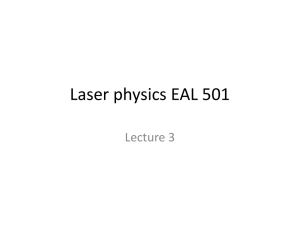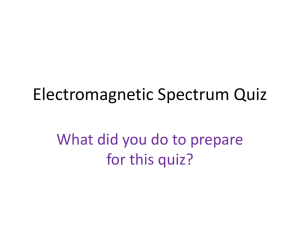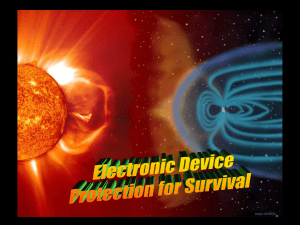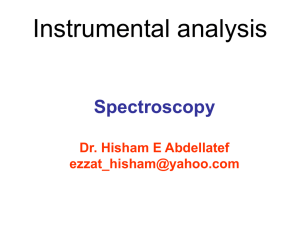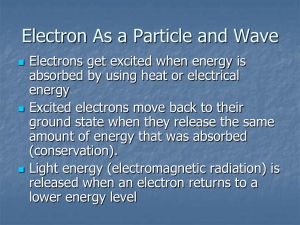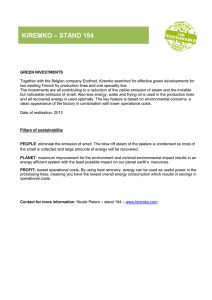Atomic Physics Revision Concept Map
advertisement
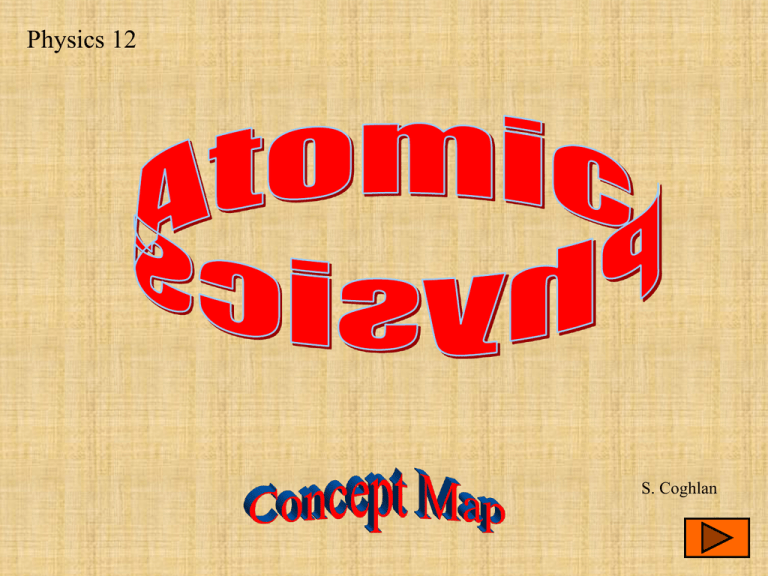
Physics 12 S. Coghlan This concept map is designed to help you; Understand how the various different parts of atomic physics link together. Study the whole section of work. Main Concepts Linking words Printer friendly version available from my web site S. Coghlan Electromagnetic radiation Bohr model(energy levels) X-ray production Mass spectrometer Atomic Physics involves explained by explains application Electromagnetic radiation involves Bohr model (energy levels) explained by Atomic Physics application Mass spectrometer explains X-ray production Electromagnetic radiation involves Bohr model (energy levels) explained by Atomic Physics Waveapplication Particle Duality Photon emitted Mass spectrometer Electromagnetic spectrum Spectra IR Vis UV Line absorption Line emission Band absorption Band emission Continuous Luminescence explains X-ray production may be may be considered makes up electron transition caused by types may be excited electron IR Duality caused by considered Photon emitted may be Vis Spectra Wave Particle may be may be Electromagnetic radiation makes up Electromagnetic spectrum UV electron transition involves Bohr model (energy levels) application Mass spectrometer excited electron explained by Atomic Physics types Luminescence explains X-ray production Line absorption Line emission Band absorption Band emission Continuous IR High energy Duality electrons Lower EK considered Produces X-rays Produces Wave ParticleX-ray spectrum Characteristic of target may be metalmay be F = qvB = mv2 Electromagnetic radiation r makes up Electromagnetic spectrum involves Photon may be metal deceleration emitted Vis caused bytarget peaks Spectramany collisions scattered electrons electron transition Bohr model (energy levels) Atomic Physics application Mass spectrometer types excited electron explained by Luminescence explains X-ray production UV centripetal Line absorption Line emission Band absorption Band emission Continuous IR Duality caused by considered Photon emitted may be Vis Spectra Wave Particle may be may be Bohr model (energy levels) Electromagnetic radiation involves makes up Electromagnetic spectrum UV electron transition excited electron explained by Atomic Physics types Luminescence Line emission Band absorption explains application Line absorption X-ray production Mass spectrometer Band emission centripetal F = qvB = mv2 metal target Produces X-rays r Produces X-ray spectrum Characteristic of target metal deceleration many collisions peaks High energy electrons Continuous scattered electrons Lower EK Your own concept map Single page concept map S. Coghlan Main Concepts Electromagnetic radiation Bohr model(energy levels) X-ray production Mass spectrometer Particle Wave Duality Photon emitted Electromagnetic spectrum Spectra IR Vis UV Line absorption Line emission Band absorption Band emission Continuous Luminescence High energy electrons Lower EK Produces X-rays Produces X-ray spectrum Characteristic of target metal F = qvB = mv2 r You can use these Main Concepts and Linking Words to complete your own concept map. You can print out the next page and use it as a framework. Linking Words Printer friendly version available from my web site involves explained by explains application may be may be considered makes up types electron transition caused by may be excited electron metal target deceleration many collisions centripetal peaks scattered electrons Printer friendly version available from my web site Atomic Physics IR Duality caused by considered Photon emitted may be Vis Spectra Wave Particle may be may be Bohr model (energy levels) Electromagnetic radiation involves makes up Electromagnetic spectrum UV electron transition excited electron explained by Atomic Physics types Luminescence Line emission Band absorption explains application Line absorption X-ray production Mass spectrometer Band emission centripetal F = qvB = mv2 metal target Produces X-rays r Produces X-ray spectrum Characteristic of target metal deceleration many collisions peaks High energy electrons Continuous scattered electrons Lower EK Electromagnetic Spectrum Increasing Energy Increasing frequency Radio Microwaves Infra-red Visible Ultra-violet X-rays Increasing wavelength -rays Cosmic rays Continuous Glowing hot solid …spectroscope e.g. hot solid, hot liquid Line absorption source…gas…spectroscope e.g. gaseous elements Band absorption source…sample…spectroscope e.g. coloured glass or coloured solution Line emission high energy gas…spectroscope e.g. gaseous elements Band emission high energy gas…spectroscope e.g. gaseous molecules or polyatomic ions Chemiluminescence Photoluminescence - exciting cause is a photon - exciting cause is a chemical reaction Bioluminescence Electroluminescence - exciting cause is an electron Phosphorescence - luminescence persists -exciting cause is a living organism Fluorescence - luminescence does not persist
